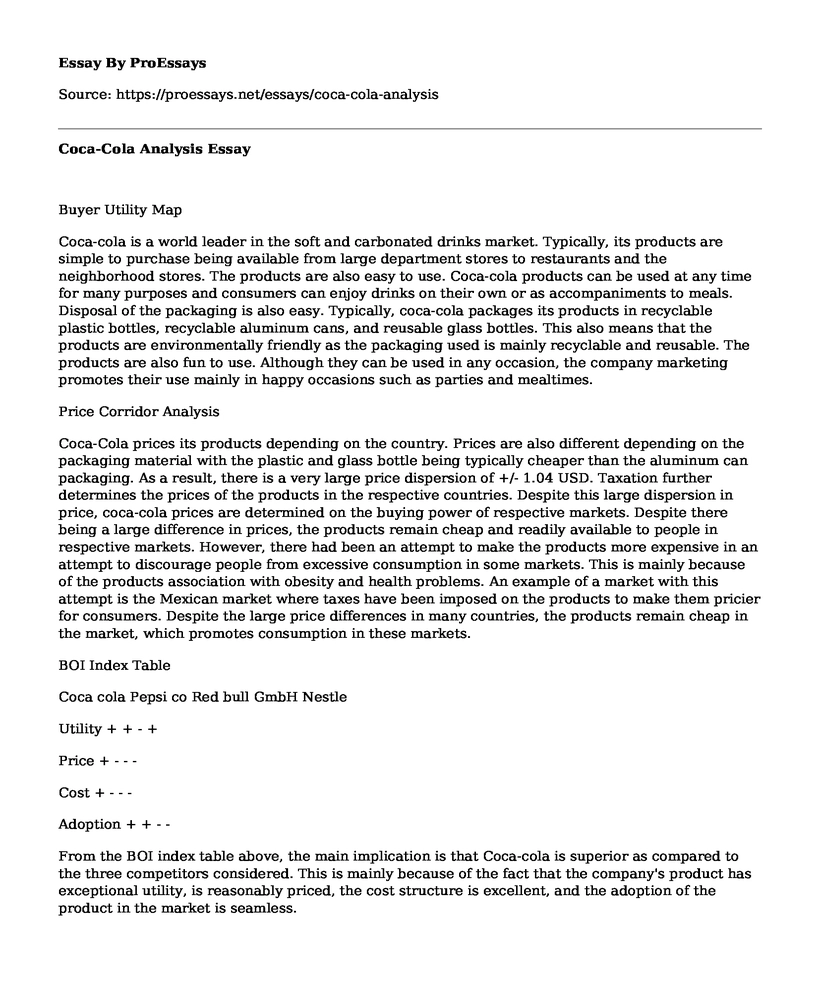Buyer Utility Map
Coca-cola is a world leader in the soft and carbonated drinks market. Typically, its products are simple to purchase being available from large department stores to restaurants and the neighborhood stores. The products are also easy to use. Coca-cola products can be used at any time for many purposes and consumers can enjoy drinks on their own or as accompaniments to meals. Disposal of the packaging is also easy. Typically, coca-cola packages its products in recyclable plastic bottles, recyclable aluminum cans, and reusable glass bottles. This also means that the products are environmentally friendly as the packaging used is mainly recyclable and reusable. The products are also fun to use. Although they can be used in any occasion, the company marketing promotes their use mainly in happy occasions such as parties and mealtimes.
Price Corridor Analysis
Coca-Cola prices its products depending on the country. Prices are also different depending on the packaging material with the plastic and glass bottle being typically cheaper than the aluminum can packaging. As a result, there is a very large price dispersion of +/- 1.04 USD. Taxation further determines the prices of the products in the respective countries. Despite this large dispersion in price, coca-cola prices are determined on the buying power of respective markets. Despite there being a large difference in prices, the products remain cheap and readily available to people in respective markets. However, there had been an attempt to make the products more expensive in an attempt to discourage people from excessive consumption in some markets. This is mainly because of the products association with obesity and health problems. An example of a market with this attempt is the Mexican market where taxes have been imposed on the products to make them pricier for consumers. Despite the large price differences in many countries, the products remain cheap in the market, which promotes consumption in these markets.
BOI Index Table
Coca cola Pepsi co Red bull GmbH Nestle
Utility + + - +
Price + - - -
Cost + - - -
Adoption + + - -
From the BOI index table above, the main implication is that Coca-cola is superior as compared to the three competitors considered. This is mainly because of the fact that the company's product has exceptional utility, is reasonably priced, the cost structure is excellent, and the adoption of the product in the market is seamless.
Three E Fair Process Analysis
Coca-cola mainly engages with its customers through its marketing campaigns. Customer feedback is also considered and is the reason why the introduction of the new coke formula was halted after mainly negative feedback. Customers are made aware of its products as well as pricing depending on the market. The company also explains its decisions to customers through these marketing campaigns. They are made aware of any changes to the products and reasons for the changes. In the history of coca-cola, the company has introduced many products but its main product has remained largely unchanged. However, packaging and branding has changed over the years and the company explains the changes to customers beforehand to ensure continued use. Through these campaigns, the company ensures that it clearly explains the effects of the implemented changes. For example, the change from exclusive use of glass bottles to use of plastic bottles allowed the customer to enjoy convenience because they could now carry the product away from the point of purchase easily. The use of vending machines has also resulted in the company being able to maintain low prices. This is explained as the reason why purchases from vending machines will typically be cheaper than purchases from stores.
References
Kelley, L., Sheehan, K., & Jugenheimer, D. W. (2015). Advertising media workbook and sourcebook. New York: Routledge
Kim, W. C., & Mauborgne, R. (2015). Blue ocean strategy: How to create uncontested market space and make the competition irrelevant (Expanded ed.). Boston: Harvard Business School Press.
Moesgaard, M., Froholdt, M., & Poulfelt, F. (2009). Return on Strategy: How to Achieve it!. Boston: Routledge.
Cite this page
Coca-Cola Analysis. (2021, Mar 08). Retrieved from https://proessays.net/essays/coca-cola-analysis
If you are the original author of this essay and no longer wish to have it published on the ProEssays website, please click below to request its removal:
- Paper Example on Strategic Management and Competitiveness: H&M Company
- Evaluation Essay on LG Corporation
- General Electric Company (GE) Strategies Paper Example
- What Is the Impact of US Government on the Future and Operations of OPEC? Essay
- Marketing Research and Consumer Behavior Paper Example
- Paper Example on Leadership Traits: My Potential From Childhood
- Essay on Pro Sports Bike: Internal Analysis to Identify Characteristics & Performance







